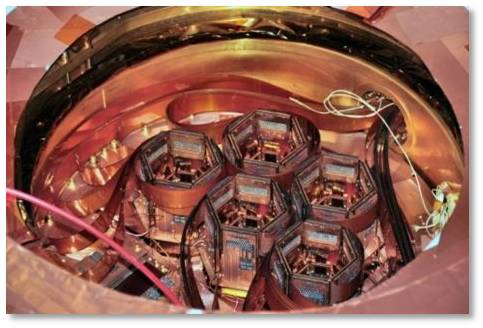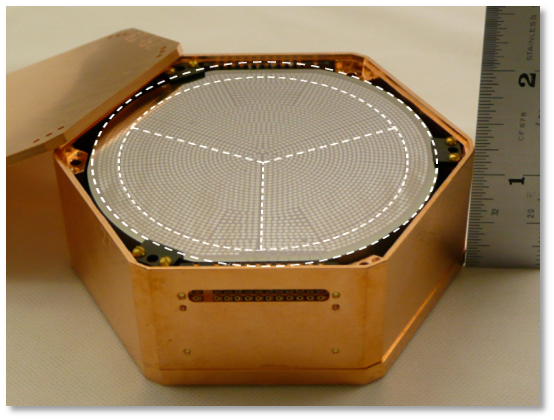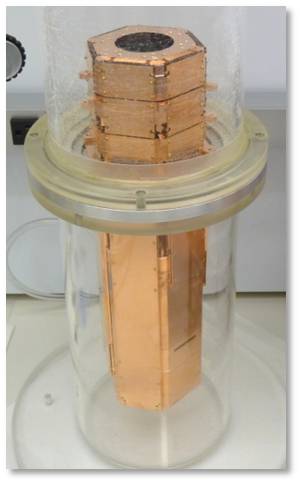CDMS
The Cryogenic Dark Matter Search (CDMS) experiment uses cryogenic germanium detectors to search for direct interactions of WIMPs with ordinary matter. In the previous section we have learned that the biggest challenge is the low interaction rate in connection with the high rate of background events. We have also learned that we should look for nuclear recoils from WIMP interactions, while most interactions from background radiation lead to electron recoils.
|
The CDMS detectors master the challenge of background discrimination by detecting two distinct signals for each interaction. The detectors are operated at a temperature of ~40 mK (-273.11°C = -459.6 F or 4/100 of a degree (C or K) above the coldest possible temperature). At this temperature a WIMP interaction would cause a measurable (even though tiny) increase in temperature. The thermal signal from an interaction is used in CDMS to determine the energy deposited. A particle interaction in a semiconductor (such as Ge or Si) produces a charge signal if a voltage is applied. The magnitude of this signal depends both on the energy deposition and on the type of interaction: an electron recoils produces a ~3 times a large a signal as a nuclear recoil of the same energy. CDMS uses the ratio of these two signals as primary discrimination parameter between signal and background. |  |
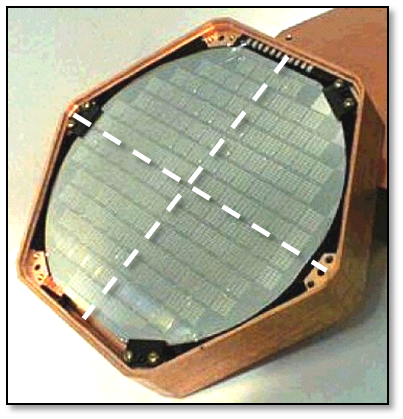 CDMS detector. The pattern on the surface is the phonon sensor, separated in four individual sensors which allows us to located where in the detector each event happened. |
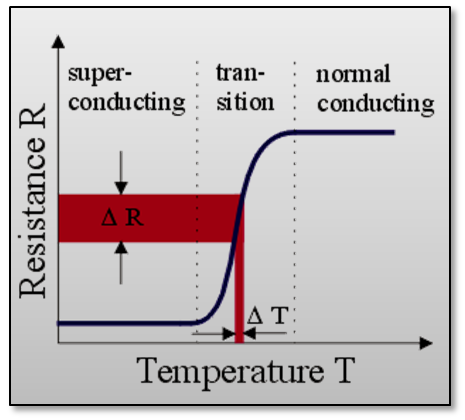 Electrical resistance as function of temperature for a superconductor around the critical temperature. The large change in resistance for a small change in temperature makes this a very sensitvie thermal sensor. |  |
The CDMS detectors are germanium disks with a diameter of 3 inches and a thickness of 1 cm (~250 g each). The thermal sensor is a superconducting thin film at the crystal surface (a superconductor is a material which loses its electrical resistance below a certain critical temperature). At the critical temperature the electrical resistance shows a very strong dependence on the temperature. The resistance is constantly monitored and a sudden change indicates a particle interaction. On a microscopic level, the thermal energy in a crystal is nothing else than the vibration of the individual atoms about their average position. The vibrations can mathematically be described as small energy packages that move through the crystal. These packages are called phonons. Therefore the thermal sensors are called phonon sensors. Each detector is equipped with four individual phonon sensors which each covers one quadrant of one of the flat surfaces of the germanium crystal. |
|
The back side of the detector is covered with a thin aluminum film through which the voltage is applied which is needed to readout the charge signal. The detectors are put together in stacks of six called tower. The towers are equipped with amplifiers for the signals and mounted in the innermost of a set of copper cans (ice box). The cans are connected via a cold finger to the different temperature stages of a dilution refrigerator which provides the low temperature needed to operate the detectors. The ice box is surrounded by lead and polyethylene shielding against radioactive radiation from the immediate environment. The whole setup is placed in the Soudan Underground Laboratory to reduce the background from cosmic radiation.
|  |
 Tower with 6 detectors. |
